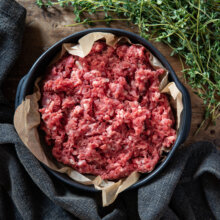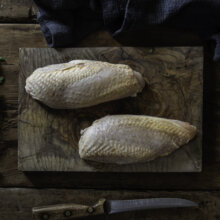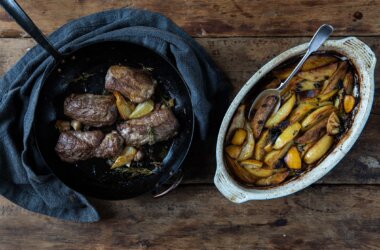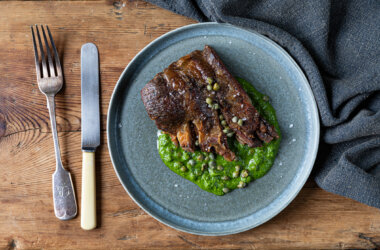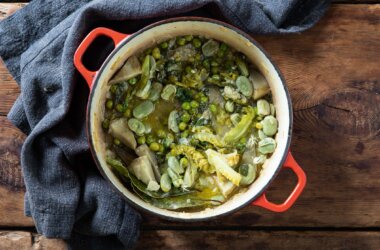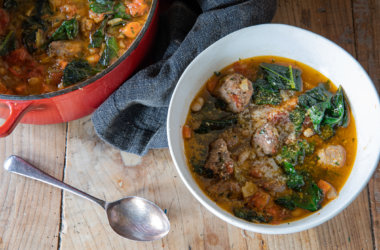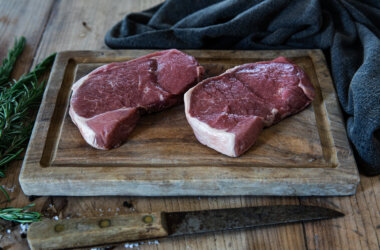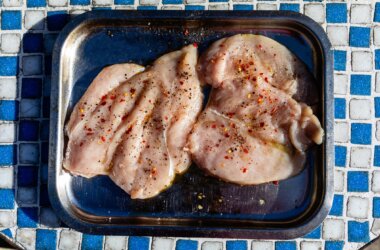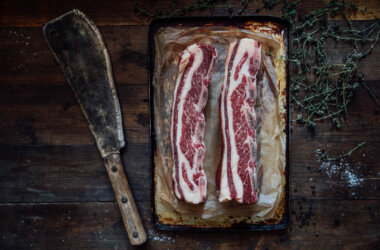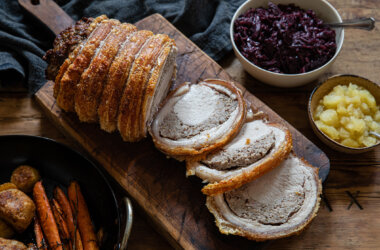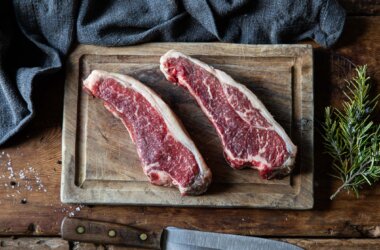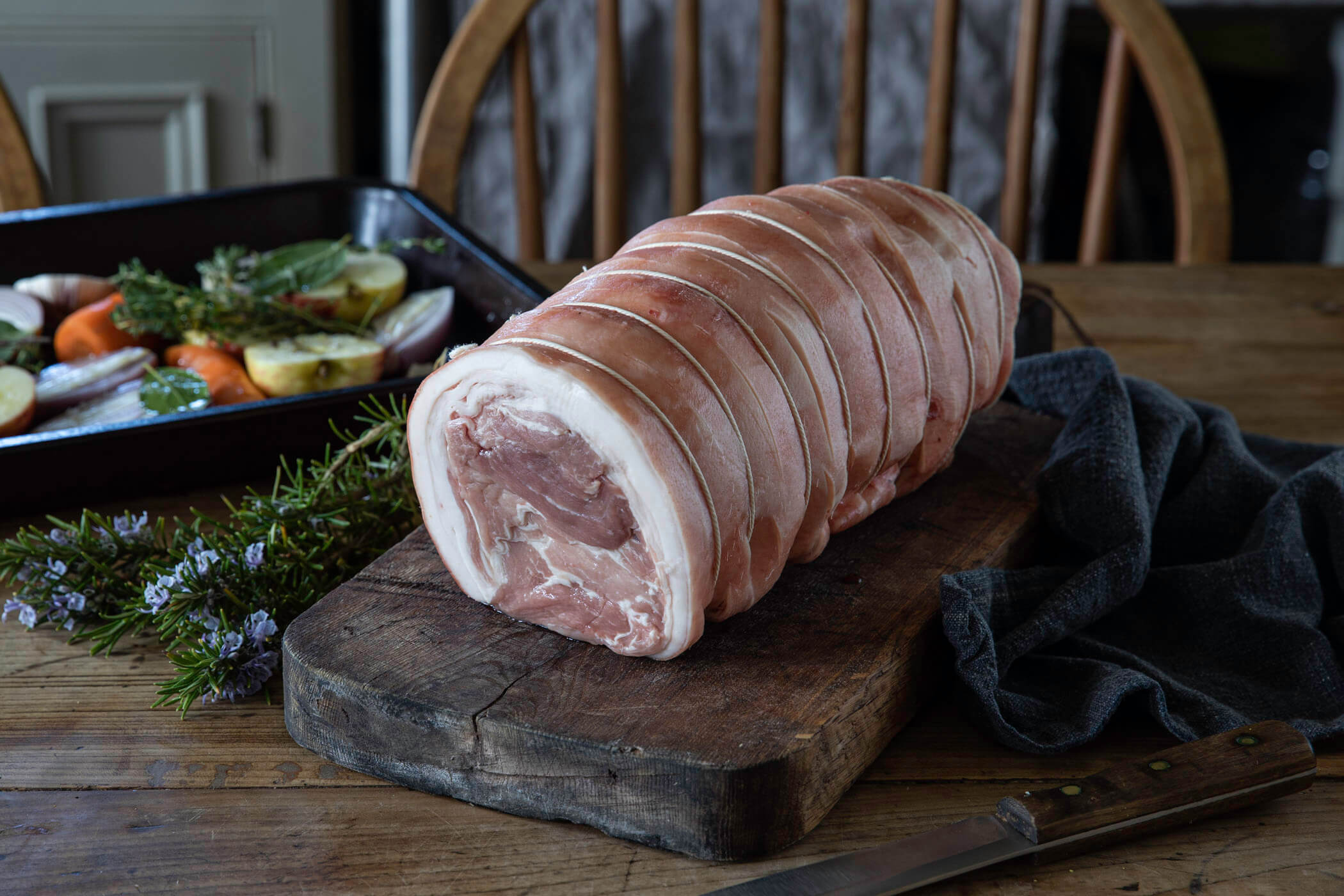
What Is a Boneless Rolled Pork Shoulder Joint?
How to Cook a Boneless Rolled Pork Shoulder Joint: A boneless rolled pork shoulder joint is the ultimate choice for a traditional pork Sunday roast. Taken from the well-marbled shoulder of high-welfare pigs, this cut is prized for its rich flavour, juicy succulence, and unbeatable crackling.
Our skilled butchers carefully tunnel-bone the shoulder to make carving easier, leaving only skin and meat before rolling and tying to size. Whether you’re feeding a crowd or planning a more intimate Sunday lunch, we’ve got the right size for you — from a generous bone-in pork shoulder that feeds 16–18 people to an 800g cut ideal for four. For guaranteed leftovers (perfect in sandwiches, noodles, or fried rice), we recommend ordering a little extra.
How Long to Cook a Rolled Shoulder of Pork?
Cooking times for a Rolled Shoulder of Pork (whether bone-in or boneless) depend on the weight of the joint — but a long, slow roast will always yield the most tender and flavour-packed results.
As a general rule, a 1.4 kg pork shoulder will take around 5–6 hours at a low temperature. This allows the fat and connective tissue to slowly break down, resulting in meat that’s juicy, pull-apart tender, and topped with perfectly crisp crackling.
For the best results, follow our low and slow method below — ideal for a comforting Sunday roast or an impressive centrepiece for weekend entertaining.
How to Cook Rolled Pork Shoulder
- Dry out the skin
Leave the pork shoulder uncovered in the fridge for around 24 hours — this helps dry the skin, which is key to achieving great crackling. - Bring to room temperature
Remove the pork from the fridge at least 4 hours before cooking to allow it to come up to room temperature. - Preheat your oven
Set your oven to 140ºC (fan 120ºC) for a slow roast. - Season generously
Rub the skin with oil and season liberally with sea salt. For extra depth, tuck garlic cloves and herbs such as rosemary or thyme into the crevices of the meat. - Prepare your roasting dish
Create a trivet of roughly chopped vegetables (onion, carrot, celery) and place the pork shoulder on top. - Add moisture
Pour in a little stock — and optionally, a splash of white wine — to build flavour and keep the joint moist. This will form the base of a delicious gravy. - Roast low and slow
Cook in the centre of the oven for approximately 5 hours, allowing the fat to render and the meat to become beautifully tender. - Finish with high heat
Increase the oven temperature to 230–250ºC for the final 20–30 minutes to crisp up the crackling. Keep a close eye to avoid burning. - Rest before carving
Remove from the oven and rest for at least 1 hour, loosely covered with foil in a warm spot. This helps the juices redistribute for maximum flavour and tenderness.
Top Tips for Cooking a Boneless Rolled Pork Shoulder Joint
- Flavour your salt: Crush a tablespoon of toasted fennel seeds and mix with flaky sea salt before seasoning the pork. It adds a beautifully aromatic layer that complements the richness of the meat and the sweetness of the crackling.
- Add apples to the roasting dish: Quarter 2–3 firm apples (like Bramley or Braeburn) and lay them in the base of the tray with your vegetables. As they roast, the apples break down and infuse the gravy with natural sweetness and depth.
- Don’t rush the rest: Resting the pork shoulder for a minimum of one hour is essential. It helps relax the fibres and reabsorb the juices, ensuring each slice is moist and tender.
- Use the fat for crisp roasties: If you’re roasting potatoes too, reserve a few spoonfuls of rendered pork fat from the roasting tray — it makes for outstandingly crispy roast potatoes.
- Add wine or cider: A splash of dry white wine or good-quality cider into the tray not only keeps the joint moist but forms the base of a rich, flavour-packed gravy.
What to Serve with a Boneless Rolled Pork Shoulder
A boneless rolled pork shoulder is incredibly versatile — equally at home as the centrepiece of a classic Sunday roast or slow-cooked until tender enough to pull apart with two forks.
Roast it low and slow for around six hours, and you’ll have beautifully succulent pulled pork, ready for bold, flavourful pairings. Think soft tacos with pickled red onions, chipotle mayo, and fresh coriander for a Mexican-inspired twist.
For a more refined take, Chef George Ryle chooses a Rindless Pork Shoulder to prepare his comforting Braised Pork Shoulder in Milk with Polenta & Crispy Sage — a nod to a traditional Italian technique that yields tender meat and an irresistibly silky sauce.
Whether you’re serving yours with apple sauce and roast potatoes or polenta and bitter greens, this cut rewards creativity as much as it does tradition.
